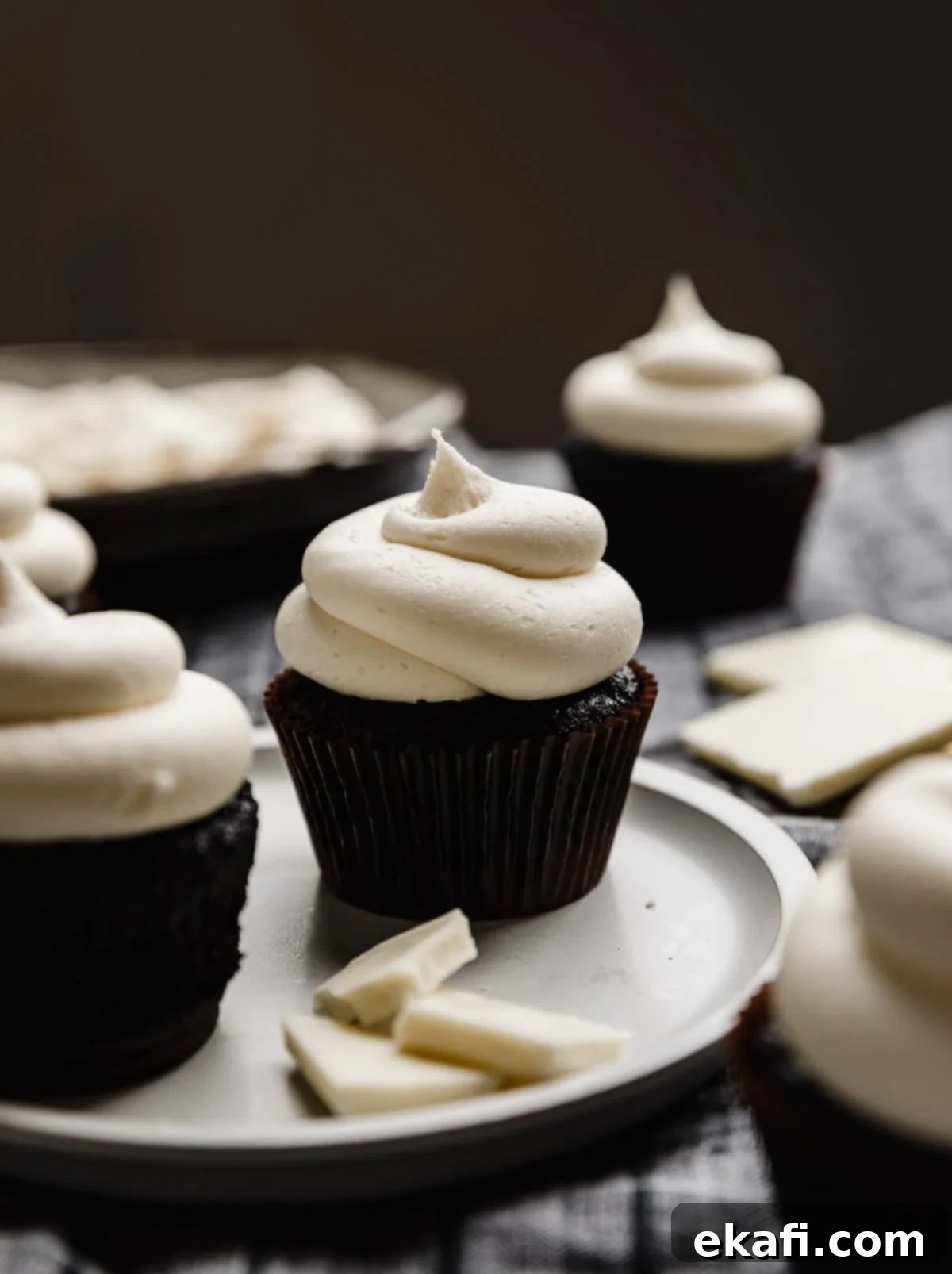Silky Smooth White Chocolate Buttercream Frosting: Your Ultimate Dessert Topping
There’s a special kind of magic in white chocolate. While some may argue its status as “true” chocolate or find its sweetness overwhelming, I’m a firm believer in its delicious charm. This white chocolate buttercream frosting recipe is not just a favorite; it’s a revelation. Its consistency is exquisitely soft and remarkably silky, transforming any ordinary dessert into something extraordinary. The addition of real white chocolate to a classic American buttercream recipe truly sets it apart, offering a depth of flavor that’s both comforting and luxurious.
This particular frosting shares a foundational resemblance to my popular Chocolate Buttercream, but with a delightful twist: instead of dark or bittersweet chocolate, it features the delicate flavor of white chocolate. I absolutely insist you try this incredible frosting atop my Oreo Cupcakes. In fact, I might even prefer it over my usual Oreo Frosting for those. The unique pairing of sweet white chocolate with the deep, dark notes of black cocoa powder creates an irresistible flavor profile that remarkably enhances the “Oreo” experience. For another decadent treat, swap out your typical frosting on Black Cocoa Brownies to achieve a similar, fabulous Oreo-like taste. Beyond these, imagine it gracing the top of a moist Carrot Cake or vibrant Red Velvet Cupcakes, offering a sophisticated alternative to cream cheese frosting. The possibilities for this versatile white chocolate buttercream are truly endless, making it a must-have in your baking repertoire!
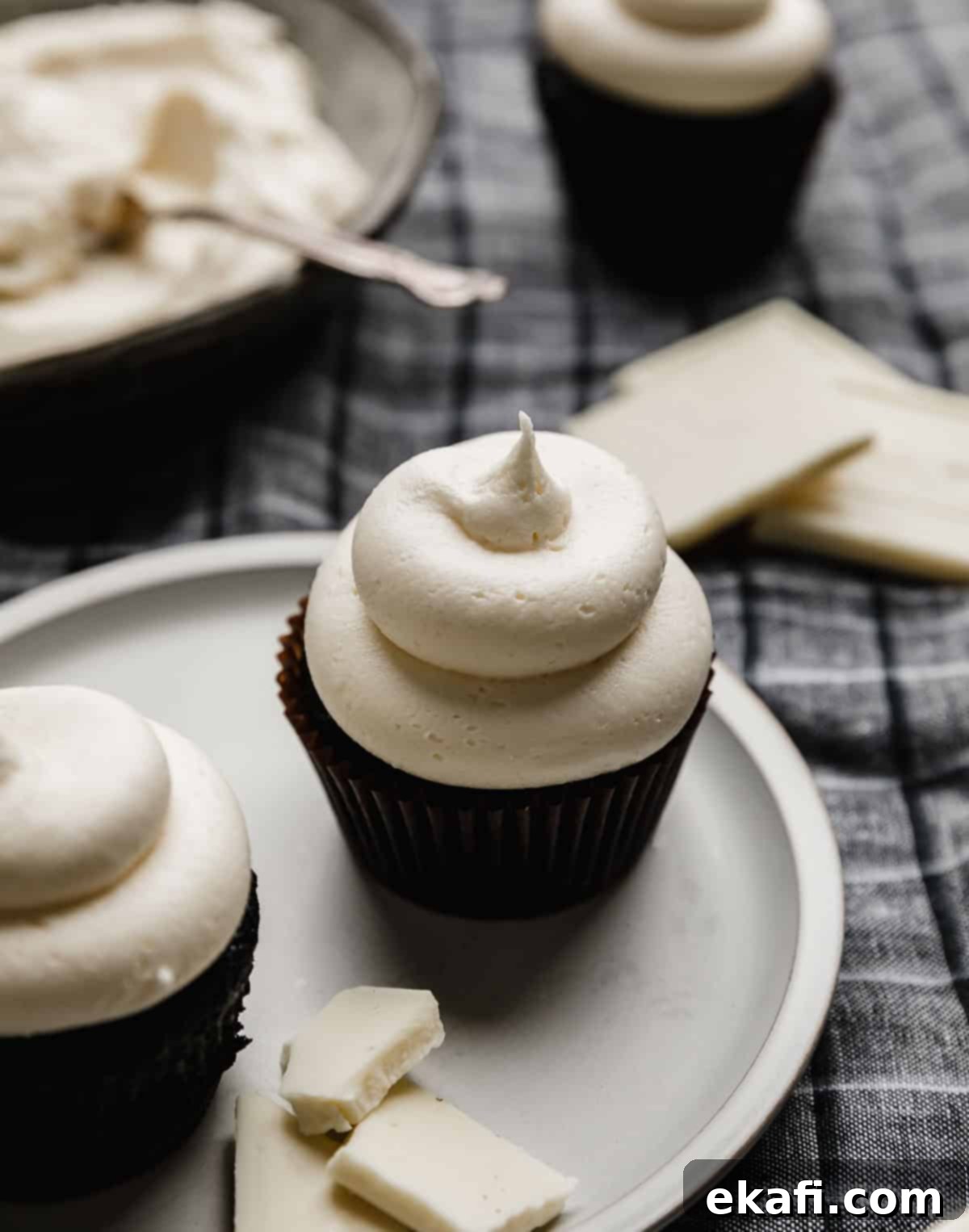
Why This White Chocolate Buttercream Recipe Works Wonders
This white chocolate buttercream frosting isn’t just another recipe; it’s designed for success and pure indulgence. Here’s why it will quickly become your go-to frosting:
- Effortlessly Easy White Chocolate Frosting. Don’t let the gourmet taste fool you—this buttercream frosting is incredibly simple and quick to prepare, even for novice bakers. The process is straightforward: you’ll start with a foundational classic American buttercream, then gently fold in smooth, melted white chocolate. With just a few basic steps and common ingredients, you’ll achieve a professional-looking and tasting frosting without any fuss. It’s the perfect recipe when you need impressive results with minimal effort.
- Bursting with Authentic White Chocolate Flavor. What truly distinguishes this recipe is its commitment to genuine white chocolate flavor. By incorporating real, high-quality white chocolate, we ensure that every bite delivers an unmistakable, rich white chocolate experience. This isn’t just a vanilla frosting with a hint of sweetness; it’s a celebration of white chocolate’s unique creamy and sweet notes, far superior to artificial flavorings. You’ll taste the difference immediately, and so will everyone else!
- Unbelievably Versatile for Any Dessert. The adaptability of this delicious white chocolate frosting is one of its greatest assets. It beautifully complements an extensive array of desserts. Imagine it enhancing the bright zest of Lemon Cupcakes, adding richness to a delicate Coconut Cake, or providing a sweet counterpoint to spicy Gingerbread Cookie Bars. For an ultimate indulgence, pair it with a classic Chocolate Cake to create a magnificent double-chocolate sensation. Essentially, wherever a traditional vanilla buttercream is called for, this white chocolate version can step in and elevate the dessert with its sophisticated flavor.
Essential Ingredient Notes for Perfect White Chocolate Buttercream
Crafting the perfect white chocolate buttercream frosting starts with understanding each ingredient’s role. Here’s a closer look at what you’ll need and why:
- Unsalted Butter: As the name “buttercream” implies, butter forms the rich, creamy foundation of this frosting. Using unsalted butter is crucial because it gives you complete control over the salt content, ensuring your frosting isn’t overly salty. Always start with room temperature butter; it whips up much smoother and creamier, incorporating air more effectively for a light, fluffy texture.
- Powdered Sugar: Also known as confectioners’ sugar, powdered sugar is key to achieving that irresistibly smooth and silky texture. Unlike granulated sugar, which can leave a gritty texture, powdered sugar dissolves seamlessly into the butter, creating a refined finish. Sifting your powdered sugar before adding it is an excellent extra step to prevent lumps and guarantee ultimate smoothness.
- Vanilla Extract: Vanilla is a classic flavor enhancer, particularly effective when paired with white chocolate. It doesn’t just add its own sweet aroma but also brightens and deepens the white chocolate’s natural sweetness and complexity, preventing the frosting from tasting flat. Opt for a good quality pure vanilla extract for the best flavor.
- White Chocolate: This is the star ingredient that delivers the unmistakable white chocolate flavor! For superior results, choose high-quality white baking chocolate or white chocolate bars. Avoid white chocolate chips if possible (more on that in the FAQ), as they contain stabilizers that can make them difficult to melt smoothly and may affect the final texture of your frosting. Chopping the chocolate into small, uniform pieces ensures even melting.
- Heavy Whipping Cream: This ingredient is optional but highly recommended. A tablespoon or two of heavy cream adds a delightful fluffiness and helps achieve a more spreadable consistency, preventing the frosting from becoming too stiff, especially as it cools. It contributes to a lighter mouthfeel and a beautifully pipeable texture. Full-fat milk can be used as a substitute if cream isn’t available, but heavy cream yields the richest results.
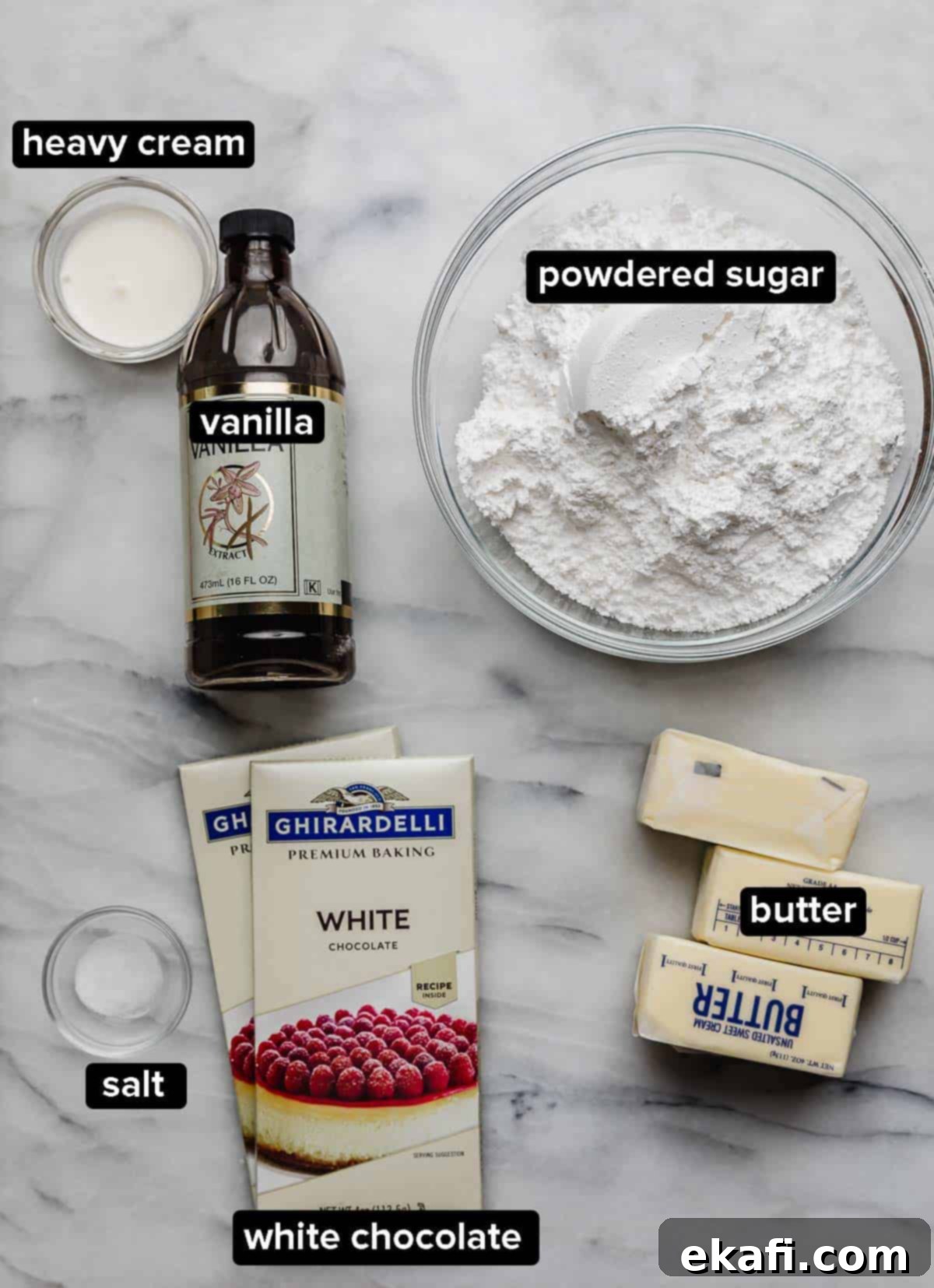
How to Make The Best White Chocolate Buttercream Frosting
Follow these simple steps to create a truly irresistible white chocolate buttercream that will impress everyone:
- Gently Melt White Chocolate. Begin by chopping 6 ounces of your chosen white chocolate into relatively uniform, rough pieces. Place these pieces into a microwave-safe bowl. Heat the chocolate at half power in short 30-second intervals, stirring thoroughly after each interval. This gentle approach is key to preventing the chocolate from scorching or seizing. Continue until the chocolate is smooth and fully melted, then set it aside to cool to room temperature. This cooling step is critical to ensure it doesn’t melt your butter when combined, which could lead to a greasy, separated frosting.
- Whip Unsalted Butter to Perfection. In the bowl of a stand mixer fitted with the paddle attachment, add 1½ cups of unsalted butter that has been softened to room temperature. This ideal temperature allows the butter to whip beautifully. Beat the butter on medium-high speed for 2-3 minutes until it becomes visibly lighter in color, pale, and incredibly smooth and fluffy. This creaming process incorporates air, which is essential for a light, airy buttercream.
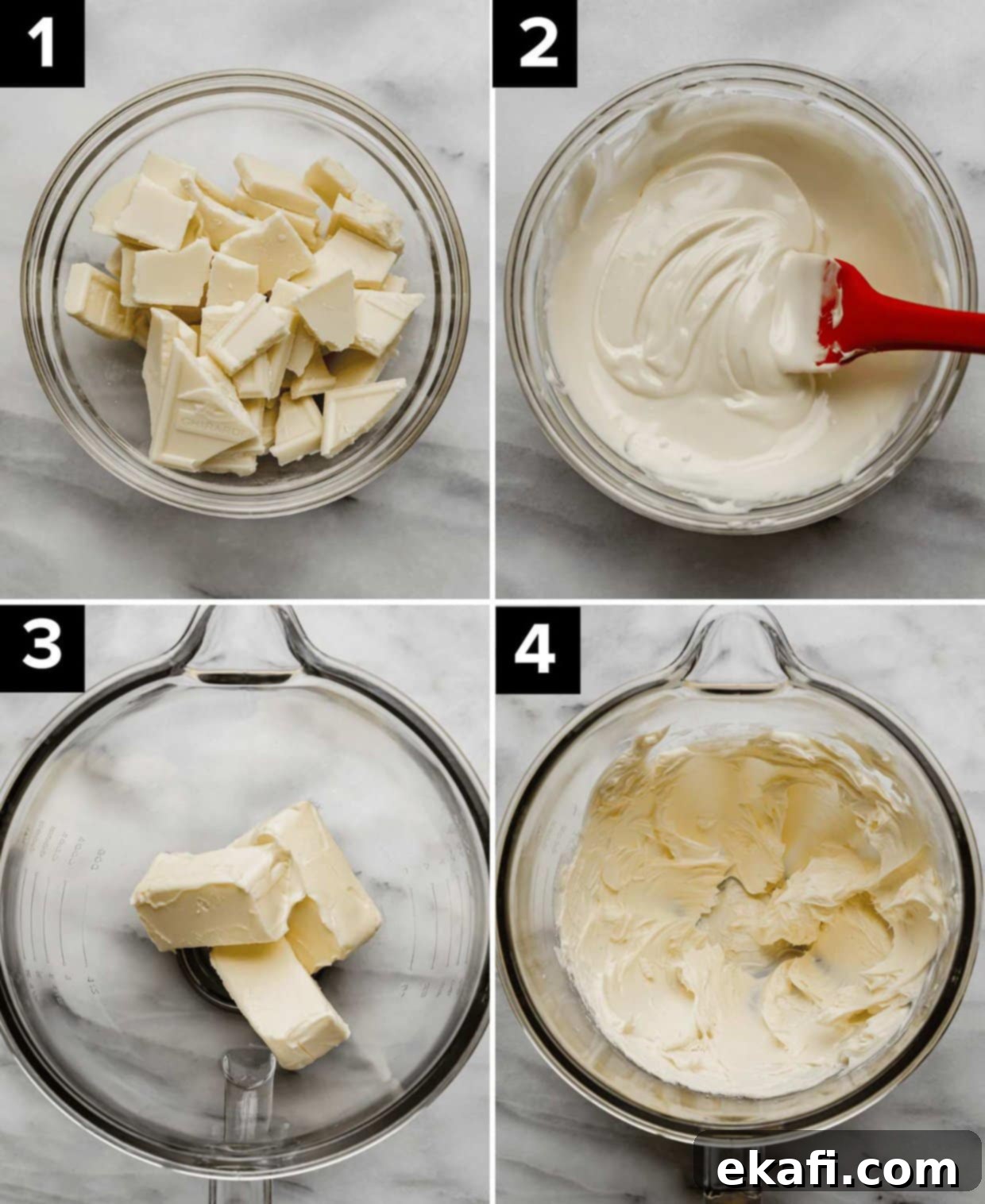
- Gradually Incorporate Powdered Sugar, Salt, and Vanilla. Reduce your mixer speed to medium-low. Slowly add 4 cups of sifted powdered sugar, one cup at a time, allowing each addition to be fully incorporated before adding more. This prevents a cloud of sugar from enveloping your kitchen! Once all the powdered sugar is mixed in, add ⅛ teaspoon of salt. The salt balances the sweetness and enhances all the flavors. Finally, pour in 1 teaspoon of vanilla extract and continue to beat for an additional 30 seconds until everything is well combined and smooth.
- Add Cooled White Chocolate for Fluffiness. With your mixer still on medium speed, carefully pour the completely cooled melted white chocolate into the stand mixer bowl with the butter and sugar mixture. Increase the speed to medium-high and beat for 1-2 minutes. This step thoroughly incorporates the white chocolate and whips additional air into the frosting, making it wonderfully light and fluffy. Be sure to stop and scrape down the sides of the bowl with a spatula periodically to ensure all ingredients are evenly mixed. If you find your frosting is too stiff at this point, you can add 1 tablespoon of heavy cream (or milk) and mix again until it reaches your desired smooth consistency. I often add the heavy cream anyway for that extra boost of fluffiness and easier spreadability.
- Time to Frost Your Favorite Desserts. Your exquisite white chocolate buttercream is now ready for action! Transfer it to a piping bag with your favorite tip or use an offset spatula to generously frost your chosen dessert. This recipe yields a substantial amount, typically enough to frost 18-24 standard-sized cupcakes (depending on how generously you apply it), or to beautifully cover a decadent 3-tier 8-inch cake. Get ready for compliments!
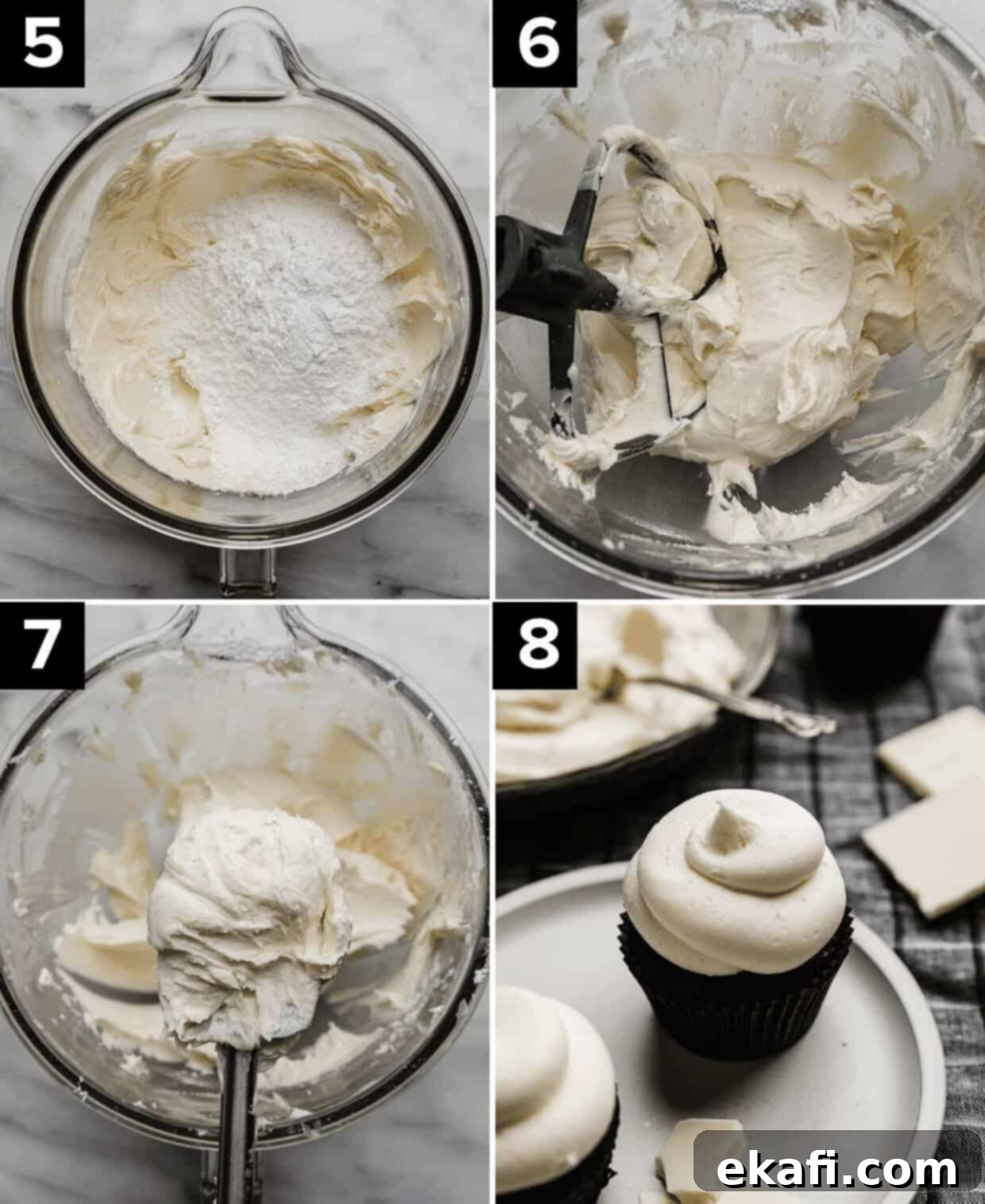
Expert Tips for Flawless White Chocolate Buttercream Every Time
Achieving bakery-quality frosting is within reach with these helpful tips:
For the smoothest possible buttercream, an extra step can make all the difference: **sift your powdered sugar** before incorporating it into the whipped butter. Powdered sugar often contains tiny clumps due to moisture, and sifting ensures these are broken up, resulting in an impeccably silky, lump-free frosting. This little effort goes a long way in perfecting the final texture.
This white chocolate buttercream serves as a fantastic **versatile base for a myriad of flavor variations**. Feel free to get creative! Consider adding a touch of peppermint extract for a festive winter treat, almond extract for a subtle nutty depth, or coconut extract to evoke tropical vibes. The possibilities are truly endless; just remember to add extracts a little at a time, tasting as you go, to achieve your desired intensity.
Given its naturally white color, this frosting is exceptionally good at **taking on various food colorings**. I highly recommend using gel food coloring over liquid dyes. Gel colors are more concentrated, meaning you need to use far less to achieve vibrant hues, which also helps prevent thinning out the frosting’s consistency. A tiny drop can create pastel shades, while a bit more will give you bold, beautiful colors.
When melting your white chocolate, exercise patience and care. It’s crucial **not to melt your chocolate completely in one go in the microwave**. Heating at half power and stirring frequently in short 30-second bursts is vital. The goal is to gently warm the chocolate enough so that the warm, already melted bits continue to melt the still-solid pieces outside of direct heat. This technique minimizes the risk of overheating, which can cause white chocolate to seize, become grainy, or even burn – a common pitfall that can ruin your frosting.
After melting, **allow the white chocolate to cool sufficiently** before adding it to your butter mixture. This step is non-negotiable for silky smooth frosting. If the melted chocolate is too hot, it will likely melt the butter in your buttercream, leading to a separated, greasy, or soupy mess that is very difficult to salvage. Aim for a temperature where the chocolate is still liquid but cool enough to touch without feeling hot.
**Adjusting consistency** is also key. If your frosting feels too thick, add heavy cream (or milk) one tablespoon at a time, mixing well after each addition, until you reach your desired spreadable consistency. Conversely, if your frosting seems too soft or runny, gradually beat in additional powdered sugar, ¼ cup at a time, until it firms up.
Make Ahead, Storing, and Freezing Your White Chocolate Buttercream
This frosting is perfect for preparing in advance, saving you time when you need it most:
Make Ahead: You can prepare this delicious white chocolate buttercream up to a week in advance. Simply store it in an airtight container in the refrigerator. For longer storage, it freezes beautifully for up to 2 months.
Storing: If you have any leftover frosting or made it ahead, transfer it to an airtight container and keep it in the fridge. When you’re ready to use it, remove it from the refrigerator and let it come to room temperature for several hours. Once softened, re-whip it with a handheld mixer or in your stand mixer for a few minutes. This process re-incorporates air, bringing back its original fluffy and spreadable texture.
Freezing: For extended storage, freeze this frosting in a freezer-safe zip-top bag (pressing out as much air as possible) or an airtight container for up to 2 months. To use, first thaw it overnight in the refrigerator. Then, allow it to come to room temperature on the counter before re-whipping it with a mixer until it’s light and fluffy again, just like freshly made buttercream.
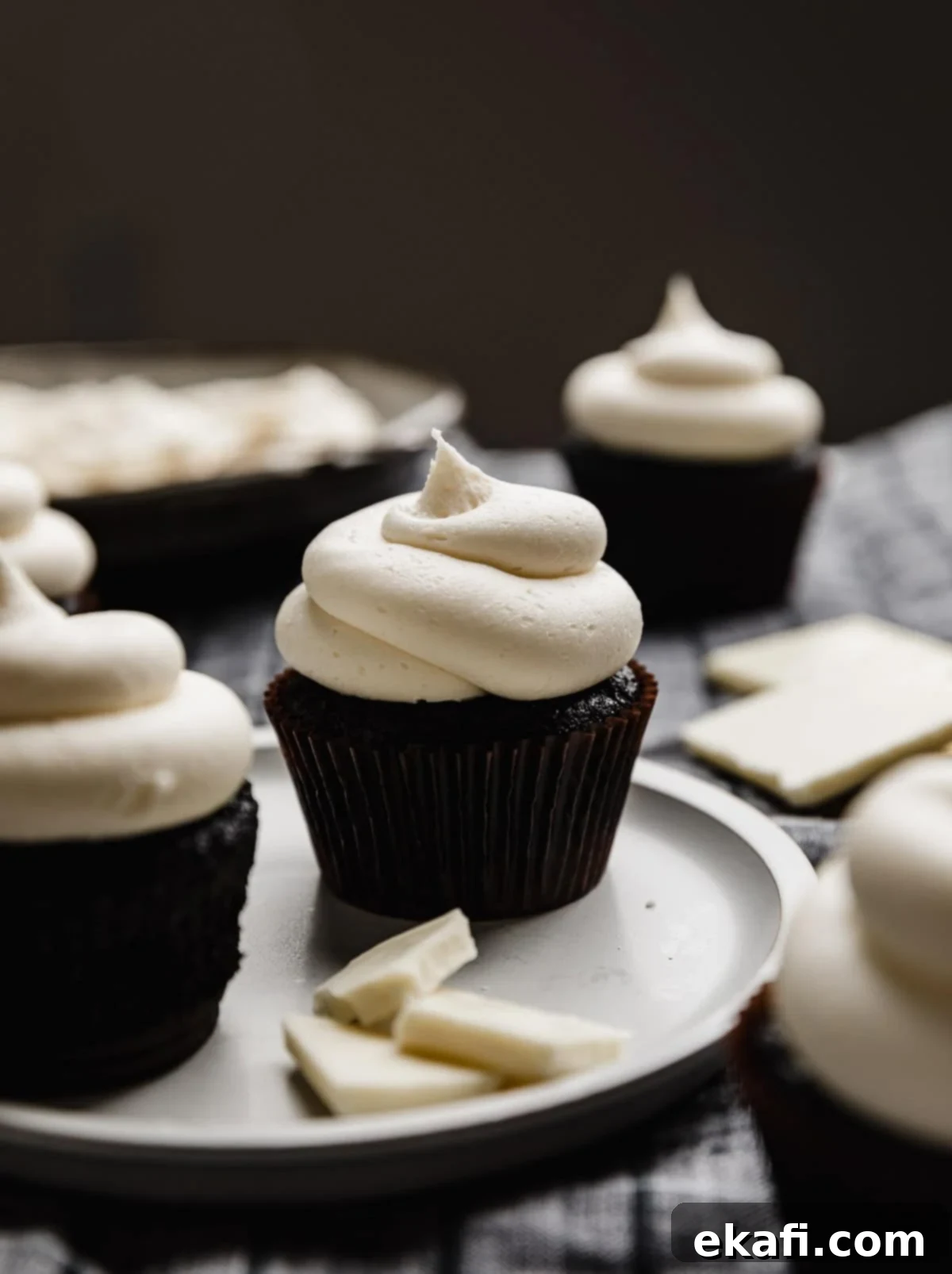
White Chocolate Buttercream Frosting FAQs
While you technically *can* use white chocolate chips, it’s not ideal and could potentially compromise the smooth, silky texture of your buttercream. Chocolate chips are formulated with added stabilizers and preservatives to help them maintain their shape during baking. This property, while great for cookies or brownies, makes them more challenging to melt smoothly and consistently. They may take longer to melt, and you might end up with a slightly grainy or less fluid result. For the absolute best, silkiest white chocolate buttercream, I strongly recommend opting for high-quality white baking chocolate bars or blocks.
Yes, due to the cocoa butter content in white chocolate, this frosting can indeed firm up and become quite thick as it cools and sets. This is a natural characteristic of chocolate-based buttercreams. For optimal ease of spreading and piping, I highly recommend using the frosting immediately after you make it to decorate your baked goods. If it sits for too long and gets too cool, it may become too stiff to work with easily. Should it stiffen up, you can gently re-whip it with a tablespoon of heavy cream or milk until it softens to a workable consistency.
I generally advise against using salted butter in baking recipes, and especially in frostings. The primary reason is that the salt content can vary significantly between different brands of salted butter, making it difficult to control the overall flavor balance of your recipe. Using salted butter could easily lead to a frosting that is unexpectedly too salty or throws off the delicate sweetness of the white chocolate. It’s always best to use unsalted butter and then add a precise pinch of salt as specified in the recipe. This allows you to taste and adjust the saltiness to your preference, ensuring a perfectly balanced and delicious white chocolate buttercream.
Achieving the perfect consistency is crucial for a great buttercream. If your white chocolate frosting is too thick, simply add more heavy cream (or milk) one tablespoon at a time, mixing well after each addition, until it reaches your desired silky, spreadable texture. Be patient and add gradually to avoid making it too thin. Conversely, if your frosting is too soft or runny, you can gradually beat in additional powdered sugar. Start with ¼ cup, mix thoroughly, and if it’s still too soft, add another ¼ cup until it firms up to a perfect consistency for piping or spreading.
Absolutely! White chocolate buttercream freezes exceptionally well, making it a great make-ahead option. To freeze, simply transfer your frosting to a heavy-duty ziplock freezer bag, squeezing out as much air as possible, or place it in an airtight freezer-safe container. It will keep beautifully for up to 2 months. When you’re ready to use it, thaw the frozen frosting in your refrigerator overnight. Once thawed, let it come to room temperature on your counter, then re-whip it thoroughly with a stand mixer or handheld mixer until it regains its light, fluffy, and smooth texture. It will taste just like it was made fresh!
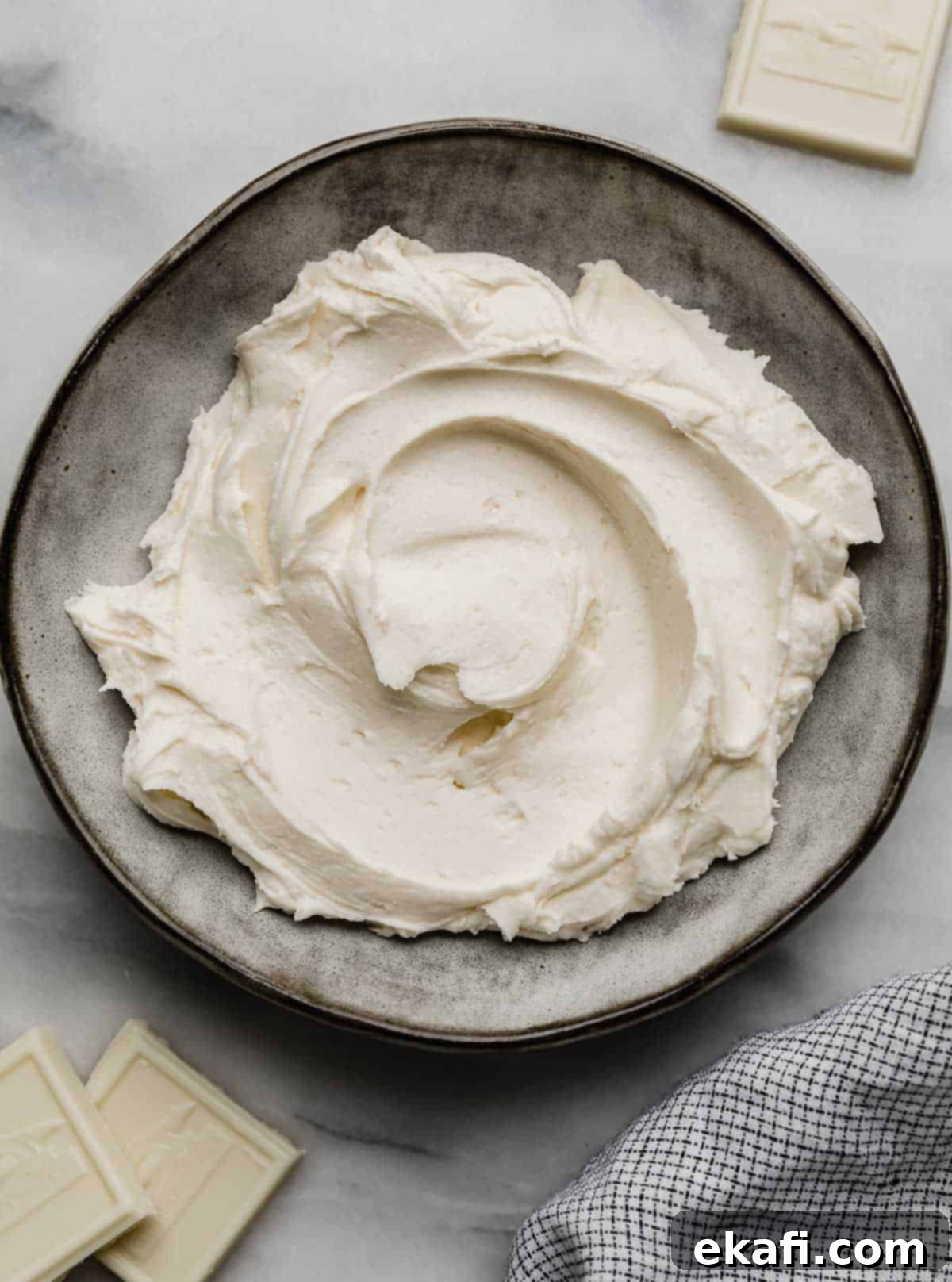
Explore More Delicious Frosting Recipes
If you loved this white chocolate buttercream, you’ll surely enjoy these other fantastic frosting creations:
- Nutella Frosting
- Lemon Frosting
- Toasted Marshmallow Frosting
- Brown Butter Cream Cheese Frosting
- Biscoff Frosting
Did you whip up this dreamy white chocolate buttercream? We’d absolutely love to hear about your experience! Please take a moment to leave a star rating and a detailed review below the recipe card. Your feedback is invaluable and helps other bakers in our community.
Stay connected and be the first to discover new delicious recipes by following us on Instagram, TikTok, YouTube, Facebook, and Pinterest. Don’t forget to tag us in your creations!
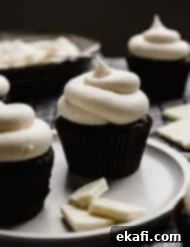
Print
SaveSaved!
Review
White Chocolate Buttercream Frosting Recipe
Ingredients
- 1 1/2 cups unsalted butter – at room temperature, softened
- 4 cups powdered sugar – sifted for best results
- 1/8 teaspoon salt
- 1 teaspoon vanilla extract – pure vanilla for best flavor
- 6 oz white chocolate – high-quality baking bar, chopped
- 1 tablespoon heavy cream – or milk, optional, for desired consistency
Equipment
-
Kitchen Aid stand mixer – or a good quality electric hand mixer
-
Microwave-safe bowl
-
Rubber spatula
Instructions
-
Chop the white chocolate into small pieces. Melt the chocolate in a microwave-safe bowl at half power, stirring every 30 seconds until completely smooth. This gentle melting prevents scorching and seizing. Once melted, set the chocolate aside to cool for at least 5 minutes, or until it reaches room temperature. It’s crucial not to add hot melted chocolate to the butter, as this will melt the butter and/or make the buttercream separated and greasy.
-
In the bowl of a stand mixer fitted with the paddle attachment, whip the room temperature unsalted butter on medium-high speed for 2-3 minutes until it’s light, fluffy, and pale in color. Reduce the mixer speed to medium. Slowly add the sifted powdered sugar, one cup at a time, allowing it to fully incorporate. Once all the powdered sugar is mixed in, add the salt and then the vanilla extract. Beat for an additional 30 seconds until well combined.
-
Pour the cooled melted white chocolate into the stand mixer bowl with the rest of the ingredients. Increase the speed to medium-high and beat for 1-2 minutes until the frosting is light, fluffy, and all ingredients are evenly incorporated. Be sure to stop and scrape down the sides of the bowl as needed. If your frosting is too stiff for your preference, gradually add 1 tablespoon of heavy cream (or milk) and beat for another minute until smooth and perfectly spreadable.
Notes
This recipe will yield enough frosting to generously frost a 3-tier, 8-inch cake, or approximately 18-24 standard cupcakes, depending on how high you pipe the frosting.
To store frosting in the fridge: Keep any leftover or make-ahead frosting in an airtight container in the refrigerator for up to 1 week. Before frosting your cake or cupcakes, remove the frosting from the fridge and allow it to come to room temperature. Then, re-whip it with a mixer until it becomes light and fluffy again, ensuring a smooth application.
To freeze: Freeze this frosting in a zip-top freezer bag, pressing out all excess air, or in a sealed, freezer-safe container for up to 2 months. To use, first thaw it in the refrigerator overnight. Once thawed, let it come to room temperature on the counter before whipping it with a mixer to restore its fluffy texture.
Nutrition
